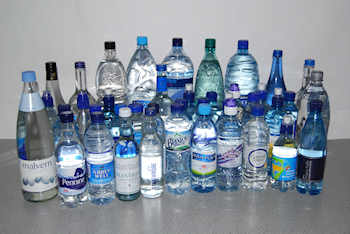Bottled water from the British Isles

The BGS has carried out a survey of the inorganic chemistry of bottled natural mineral waters and spring waters from across the British Isles.
We analysed 85 samples from 67 groundwater sources from a diverse range of aquifer rock types.
Analyses included the major ions and a wide range of trace elements.
Background
Try to find out the chemistry of mains water supplied to your home tap and the chances are you will come across a comprehensive list of analytes, at least in summary form, on the web.
The chemistry of bottled water is less easy to find and although most manufacturers supply representative major-ion data on the labels, trace elements are not commonly included.
We set about analysing the major ions and a range of trace elements in a selection of still British bottled waters, available from retail outlets across the British Isles.
Research findings
Results of the study showed that:
- concentrations of the inorganic constituents analysed were well within the limits for compliance with European and national standards for bottled waters;
- a small number of samples had relatively high uranium (U) concentrations (10–13 µg/L), though none exceeded the current provisional WHO guideline value for uranium in drinking water (30 µg/L) and no European limit currently exists for uranium in bottled water;
- concentrations of antimony were higher in water samples contained in PET (plastic) bottles compared to those contained in glass and compared to raw groundwater samples from the corresponding aquifers. The increases are likely derived from contamination from the PET bottles. In no cases however, did the concentrations approach the limit for antimony in natural mineral waters or water intended for human consumption (5 µg/L);
- in comparison with raw groundwaters from equivalent aquifers in Britain, the bottled waters had lower overall concentrations of Al, Cd, Cu, Fe, Mn, Pb, and Zn, consistent with loss by processing before bottling (e.g. by aeration, settling, filtration); choice of material used for pipework at the bottling plants may be an additional factor.
Results suggest that although for the most part the major ions in the bottled waters appear representative of the groundwater in their host aquifers, many of the trace elements appear to have been modified significantly from natural compositions underground as a result of processing.
Further information
Smedley, P, L. 2010. A survey of the inorganic chemistry of bottled mineral waters from the British Isles. Applied Geochemistry, 25, 1872–1888.
Contact
Contact Dr Pauline Smedley for further information






